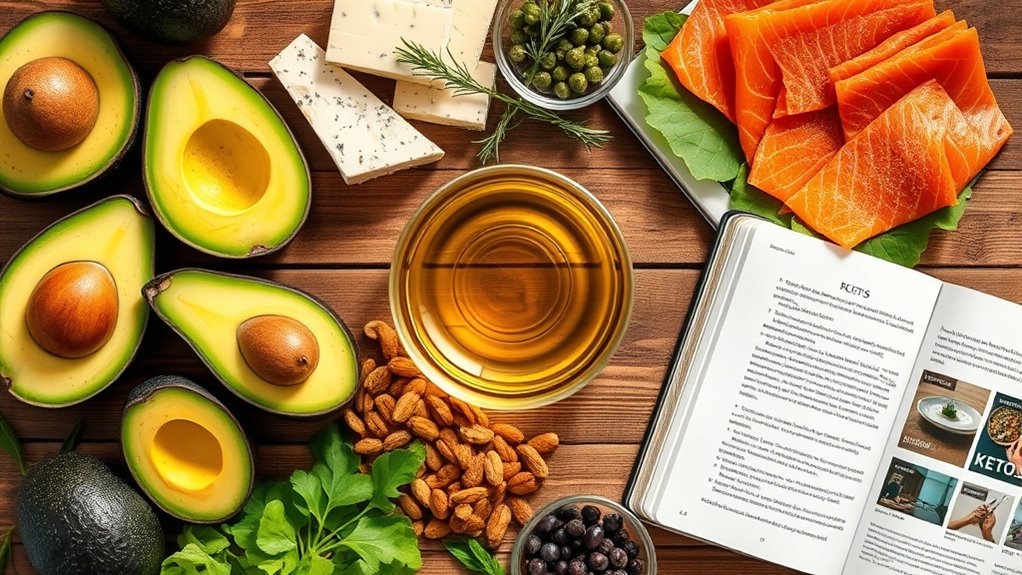The keto diet plan is a low-carbohydrate, high-fat dietary strategy aimed at inducing ketosis, where your body uses fat instead of glucose for energy. You’ll typically consume around 70-75% fats, 20-25% proteins, and only 5-10% carbohydrates. This shift can lead to significant weight loss, improved mental clarity, and increased energy levels. By following key principles and focusing on specific foods, you can embrace this lifestyle and discover more benefits along the way.
Understanding Ketosis and Its Importance

When you begin a keto diet, understanding ketosis is essential for achieving your health goals. Ketosis is a metabolic state where your body shifts from using glucose for energy to burning fat, which is facilitated by ketosis mechanisms. This change involves a significant metabolic adaptation, where your body becomes more efficient at utilizing ketones as an energy source. As you limit carbohydrate intake, insulin levels drop, prompting the liver to produce ketones from fatty acids. This process not only supports fat loss but may also enhance mental clarity and energy levels. Recognizing these mechanisms empowers you to harness ketosis effectively, allowing for greater freedom in your dietary choices while working towards ideal health and wellness.
Key Principles of the Keto Diet

To effectively follow the keto diet, you’ll need to understand the key principles that govern its success. This includes adhering to specific macronutrient ratios that promote ketosis, where your body shifts to burning fat for fuel. In this section, we’ll explain the ketosis process and how these ratios play an essential role in achieving your dietary goals.
Macronutrient Ratios
Understanding macronutrient ratios is essential for anyone looking to successfully implement the keto diet. Achieving the right macronutrient balance allows you to thrive within dietary restrictions while enjoying a variety of foods. Here’s a quick breakdown of the ideal ratios:
- Fats: 70-75% of your daily intake, focusing on healthy sources like avocados and olive oil.
- Proteins: 20-25% for muscle maintenance, emphasizing lean meats and fish.
- Carbohydrates: 5-10%, primarily from leafy greens and non-starchy vegetables.
- Fiber: Maintain adequate intake to support digestion and overall health.
Ketosis Process Explained
As you begin on the keto diet, grasping the concept of ketosis is essential for harnessing its benefits. Ketosis is a metabolic state where your body shifts from burning carbohydrates to utilizing fats for energy. This process, known as keto adaptations, helps your body become more efficient at accessing stored fat, promoting weight loss and improved energy levels.
| Metabolic State | Description |
|---|---|
| Carbohydrate | Glucose is the primary fuel |
| Ketosis | Fats are converted to ketones |
| Energy Source | Fat becomes the main energy source |
| Adaptation Time | Typically takes 1-2 weeks |
Understanding these principles will empower you to embrace your keto journey with confidence and freedom.
Health Benefits of Following a Keto Diet

When you follow a keto diet, you may experience significant weight loss, as the body shifts from burning carbs to burning fat for fuel. This metabolic change can also enhance your mental clarity, helping you focus more effectively throughout the day. Understanding these benefits can motivate you to embrace the keto lifestyle for both physical and cognitive improvements.
Weight Loss Efficiency
While many diets promise quick results, the keto diet stands out for its unique approach to weight loss. By incorporating dietary restrictions that considerably lower carbohydrate intake, you encourage your body to enter a state of metabolic adaptation. This shift accelerates fat burning, leading to effective weight loss.
Here are four key aspects of the keto diet that enhance its weight loss efficiency:
- Increased satiety: High-fat foods keep you fuller longer.
- Stable blood sugar: Reduced carbs prevent spikes and crashes.
- Enhanced fat oxidation: Your body becomes efficient at burning stored fat.
- Reduced appetite: Ketones produced during fat burning suppress hunger.
Embracing these principles can empower you to achieve your weight loss goals with greater freedom and ease.
Improved Mental Clarity
One of the remarkable benefits of following a keto diet is improved mental clarity, which many people experience as they adapt to this low-carb lifestyle. Research suggests that ketosis enhances brain function by providing an efficient energy source, ketones, which are more effective than glucose. This shift can lead to cognitive benefits such as sharper focus, better memory, and reduced brain fog. You might notice that tasks requiring concentration become easier, allowing for greater productivity. In addition, some studies indicate that a keto diet may help protect against neurodegenerative diseases by supporting neuronal health. Embracing this diet not only aids in physical health but also empowers your mind, releasing your potential for clarity and creativity.
Foods to Include in a Keto Meal Plan
To successfully navigate a keto meal plan, it is vital to focus on foods that are low in carbohydrates and high in healthy fats. Embracing the right ingredients not only fuels your body but also makes meal prep enjoyable. Here are some essential foods to include:
- Avocados – Packed with healthy fats and fiber, they’re perfect for salads or snacks.
- Nuts and Seeds – Great for keto snacks, they provide essential nutrients and keep you satiated.
- Fatty Fish – Rich in omega-3 fatty acids, options like salmon and mackerel support overall health.
- Low-Carb Vegetables – Leafy greens, broccoli, and cauliflower are nutrient-dense and versatile.
Foods to Avoid on a Keto Diet
Maintaining a keto diet requires not only incorporating the right foods but also avoiding certain items that can disrupt your state of ketosis. First and foremost, steer clear of high-carb foods like bread, pasta, and rice. These can quickly push you out of ketosis. Additionally, be cautious of hidden sugars found in many sauces, dressings, and even some so-called keto snacks. Always check labels for added sugars, which can sabotage your efforts. Fruit is another area to watch; opt for low-sugar options like berries while avoiding bananas and grapes. Finally, processed foods often contain unhealthy ingredients that may not align with your goals. By being mindful of these foods, you’ll have a better chance of maintaining the freedom that comes with a successful keto lifestyle.
Tips for Transitioning to a Keto Lifestyle
As you start your journey to a keto lifestyle, it’s essential to approach the change thoughtfully to minimize discomfort and maximize success. Here are some tips to help you shift smoothly:
- Plan Your Meals: Invest time in meal prep to guarantee you have keto-friendly options readily available.
- Grocery Shopping: Create a shopping list focused on low-carb vegetables, healthy fats, and quality proteins to avoid impulse purchases.
- Stay Hydrated: Drink plenty of water to help your body adjust and reduce potential side effects.
- Gradual Change: Slowly reduce carb intake over a few days to allow your body to adapt without overwhelming it.
These steps will empower you to embrace a keto lifestyle with confidence and clarity.
Potential Challenges and How to Overcome Them
While shifting to a keto diet can offer numerous health benefits, it’s not without its challenges. One common hurdle you might face is keto cravings, especially during the initial shift phase. To combat this, focus on high-fat, low-carb snacks to keep hunger at bay.
Social situations can also pose a dilemma, as dining out or attending events might tempt you with non-keto options. To navigate these scenarios, plan ahead by reviewing menus or bringing your own dishes to share.
Staying informed and connected with others on the keto journey can provide valuable support and motivation. By addressing these challenges head-on, you can maintain your commitment to a keto lifestyle while enjoying the freedom it brings.


